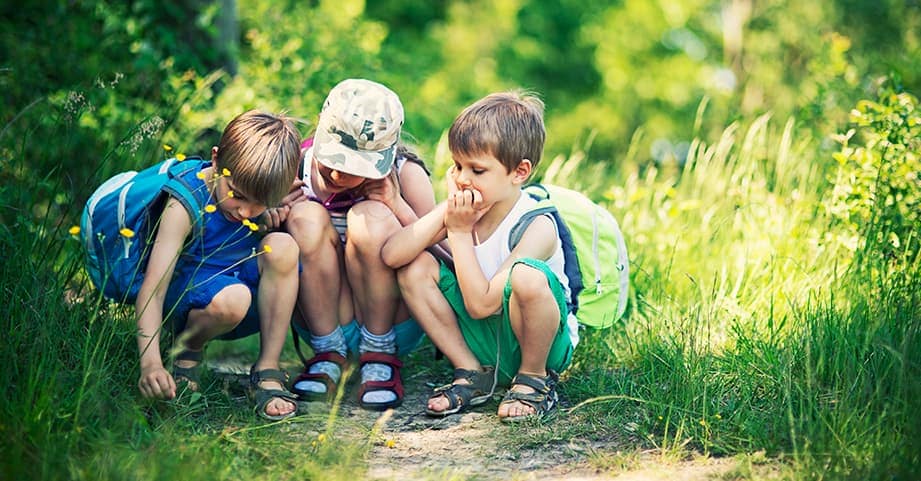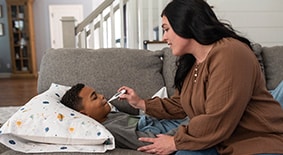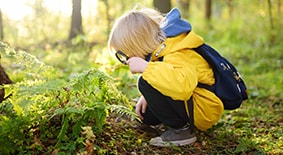What Parents Need to Know: Snakes, Bees, Bugs & Toxic Plants
Warmer weather means more opportunities to get outdoors. But it also means your child is more likely to cross paths with creepy, crawly, slithery, itchy things that could cause them harm. Before you venture out, get a rundown of some of the most common culprits for bites, stings and rashes; tips on how to recognize serious side effects; and how to respond if your child is bitten or exposed.
For many of us, any snake is a bad snake. But of the 40-plus species of snakes in Georgia, only six are actually venomous and have the potential to do harm. Another fact to put your mind at ease: snakes aren’t known to be aggressive, so they typically won’t bite unless startled or provoked. Still, snake bites do happen. Around 450 bites per year are reported in Georgia. So as parents, it’s important to be informed—just in case.

Types of Venomous Snakes
Unfortunately, it’s not always easy to distinguish one snake from the next. Learn how to identify the markings and other characteristics of venomous species by doing a little research. Here are the most common types of poisonous snakes in Georgia.
- Copperhead
- Eastern Coral
- Cottonmouth
- Timber Rattlesnake
- Pigmy Rattlesnake
- Eastern Diamondback Rattlesnake
Typically, these snakes are not hanging out in the suburbs of Atlanta, according to Rebecca Burger, MD, pediatric emergency medicine physician. “Most poisonous snakes will be in the mountains on a rocky hillside or in the lowlands, in a forest or near water,” she says. “And they tend to avoid extreme temperatures, so they’re most often spotted in spring and early summer.”
Signs of a Snake Bite
Unless you see a snake bite your child—or your child is older and can describe exactly what happened—it may be challenging to determine whether it was a snake that caused their injury, not to mention what kind of snake did the deed. You’ll have to rely on their symptoms and the appearance of the bite for clues.
“Often kids will complain about a bite or sting, but parents won’t know what caused it,” says Dr. Burger. “Generally, a snake bite will have two puncture marks side by side, so parents should look for those.” Other common signs of a snake bite will occur at the site of the injury. They include:
- Pain
- Redness
- Swelling
Serious Side Effects of a Snake Bite
More severe symptoms resulting from a venomous snake bite are not as common. “Of the 466 snake bite calls received by Georgia Poison Control, only 20% of them involved patients who required antivenom treatment,” says Dr. Burger.
Symptoms to look out for that may signal a more serious reaction include:
- Significant swelling beyond the site of injury
- Extreme pain not relieved with medication
- Elevated heart rate
- Low blood pressure
- Vomiting
- Uncontrolled bleeding
How to Treat a Snake Bite
If you believe your child has been bitten by a snake, particularly if you know that it was a venomous snake, then it's a good idea to call Georgia Poison Center 404-616-9000. They are the experts and can walk you through the best way to treat the bite and when to seek additional medical care.
“Most often, snake bites are not serious and symptoms are mild and resolve on their own. Calling the Poison Center can help save you a trip to the ER,” says Dr. Burger. “However, parents should follow up with their pediatrician or primary care provider even if the bite is not serious.”
For mild symptoms, parents should:
- Wash and cover the wound
- Offer an over-the-counter pain reliever
- Elevate the wound if it’s on an extremity
More serious side effects typically occur within a few hours of the snake bite. Treat the mild symptoms and observe your child carefully. If they begin experiencing any of the more serious side effects listed above, take them to the closest urgent care center or emergency department.
Snake Bite Myths and Misconceptions
Some of the advice you may have heard about how to respond if you or a loved one gets bitten by a snake isn’t just false—it could be dangerous.
Here’s what NOT to do after a snake bite:
- Do not try to capture or kill the snake.
- Do not apply a tourniquet or restrict blood flow.
- Do not cut open the wound.
- Do not attempt to suck venom from the wound.
- Do not apply heat or cold to the bite.
Summertime is mosquito season in Georgia. They are the most common pest we think of when we think about bug bites. Fortunately, unless your child scratches excessively and the bites become infected, itchiness is the only side effect. But there are other insects and bees that can cause more serious reactions if your child is bitten or stung.
Bees and Wasps
Bumblebees (females, not males) can sting when threatened, but typically they’re more focused on their very important work: pollination. Wasps, on the other hand, are the more aggressive bee cousin and are most often to blame for a painful sting. There are a variety of wasp species, but the most common stinging wasps in Georgia are:
- Yellowjackets
- Paper wasps
- Hornets
Signs of a Bee or Wasp Sting
The most common sign of a bee or wasp sting is the localized reaction around the bite itself. Your child may experience pain, redness and swelling, followed by itching. These symptoms will typically subside over time. “What we’re most concerned about with stings is the potential for an allergic reaction or anaphylaxis,” says Dr. Burger.
Signs of a more serious allergic reaction include:
- Significant swelling
- Trouble breathing
- Difficulty swallowing
- Vomiting
- Passing out
Treating a Bee or Wasp Sting
If your child shows any symptoms of an allergic reaction after being stung, call 911 or come to the ER immediately. If your child has had an allergic reaction to a sting in the past and you have access to epinephrine (EpiPen), follow the instructions you were provided and administer treatment.
To treat mild symptoms of a sting, Dr. Burger recommends ice for swelling and pain relief, as well as an oral antihistamine and topical steroid cream. If you see a stinger, remove it carefully with tweezers rather than by hand.
Insects and Spiders
As with bee stings, if your child is bitten or stung by an insect or spider, the most important thing to look out for are signs of an allergic reaction. Here are some common bugs and not-so-common spiders that you should be aware of.
Chiggers
Chiggers are tiny red mites that hang out in tall grass, in the woods, by streams—just about anywhere outdoors. They like to tag along on pant legs or socks and nestle into moist, warm places like under the arms or around the groin. Their bites aren’t dangerous, but they are extremely itchy and annoying. Sometimes swelling can be significant, so Dr. Burger recommends antihistamine and applying ice to relieve symptoms.
Ticks
Like chiggers, ticks are often found in wooded areas. They’re parasites, and they feed on the blood of their host, whether animal or human. Their bite isn’t painful and may not cause any symptoms beyond some redness and itching. Unfortunately, these tiny pests can transmit bacteria, viruses and diseases. The most common of these is Lyme Disease. If you find a tick on your child, remove it carefully with tweezers by tugging at its head until it releases. Wash the area thoroughly and keep an eye out for additional signs of infection, such as a rash, flu-like symptoms or pain and blistering. These symptoms require further evaluation by your pediatrician.
Fire Ants
Fire ants are small, but they attack in swarms if threatened. Bites from multiple fire ants can cause significant pain, as well as swelling. Their venom can also cause an allergic reaction in some people. Keep an eye out for hives all over the body and difficulty breathing. If these symptoms appear, seek immediate treatment.
Spiders
They may be scary to look at, but most spiders are not harmful. In Georgia, we have just a handful of species of spider that are poisonous. However, none are very common. Two you may be familiar with are:
Southern Black Widow
If you don’t see the spider, you might not know your child has been bitten by a black widow. There are no distinct marks or signs that distinguish the bite itself beyond just redness and swelling. But if your child has a systemic reaction to the venom, they may experience weakness, nausea, vomiting and headache. If you suspect your child’s bite may have been from a black widow spider, wash the wound well and apply an ice pack. Call the Poison Center as a precaution and keep an eye out for other symptoms.
Brown Recluse
A brown recluse bite is easier to identify. They are extremely painful and will cause the skin to turn dark black in the center of the bite, with a red ring on the outside. “If you see this kind of mark on your child after a bite, then seek treatment right away,” says Dr. Burger. “Like a snake bite, brown recluse venom can lead to bleeding issues and can impact other organs, so they need to be checked for systemic involvement.”
Most poisonous plants can cause mild symptoms if they touch your child’s skin. But if they’re ingested or swallowed, some plants can be fatal.
Exposure to Poison Ivy, Poison Oak and Poison Sumac
These poisonous plants are commonly found out in the woods or around the yard. It’s important to be able to recognize them, so you can keep your child from being exposed. Each contains an oil that can cause an allergic reaction if it gets on your skin. Most often, this reaction appears as an itchy rash, blisters, redness and swelling.
How to Treat
To relieve the itchy rash caused by one of these poisonous plants, Dr. Burger recommends:
- Bathing the child in the shower as quickly as possible to remove all oil from the skin and keep it from spreading to other parts of the body.
- Applying topical anti-itch creams.
- Giving oral antihistamines.
When to Seek Medical Attention
Sometimes, exposure to one of these poisonous plants can require medical treatment. “If you are mowing the lawn or any time these plants become aerosolized, then your child can inhale the oils,” says Dr. Burger. “In these cases, kids may experience anaphylactic-like symptoms, including swollen eyes, trouble breathing and difficulty swallowing.” If this occurs, you should take your child to an urgent care facility or ER for evaluation.
Dangers of Eating Poisonous Plants
Little ones are bound to put things in their mouths. So, if you have one of these plants in or around your home, be sure they’re out of reach. If swallowed, some can be fatal. Some of the most dangerous poisonous plants include:
Oleander
These tall shrubs are commonly found in South Georgia or along the coast, but their pastel-colored flowers are a favorite for gardeners closer to Atlanta, too. Unfortunately, the oils of the oleander are poisonous. They can cause serious illness or even death if ingested. “A child who swallows oleander may have dizziness, irregular heartbeat or tremors and requires medical treatment,” says Dr. Burger.
Lilies
There are many different varieties of lilies. All can cause illness if ingested. Symptoms may include upset stomach and vomiting. But some lilies may cause a more serious reaction. Lily of the valley can cause irregular heart rate and/or confusion, in addition to stomach upset. “Cala lilies are especially dangerous,” says Dr. Burger. “They can be fatal if swallowed in large quantities.”
Caladiums
Also known as elephant ears, caladiums are deep green with a cotton-candy-colored center. But unlike cotton candy, if kids eat this plant, they’ll experience painful symptoms, including burning of the mouth and swelling of the lips, tongue and throat, which can lead to airway obstruction or trouble swallowing.
Hemlock
This is a weed with clusters of tiny white flowers and fern-like leaves that can take over sunny fields or roadsides. Eating even small amounts of this plant can be fatal. “This toxic plant can cause problems with the central nervous system, trouble breathing and organ failure,” says Dr. Burger.
Rebecca Burger, MD, is a pediatric emergency medicine physician for Children's Healthcare of Atlanta who cares for kids at Hughes Spalding Hospital and Egleston Hospital emergency departments.
This content is general information and is not specific medical advice. Always consult with a doctor or healthcare provider if you have any questions or concerns about the health of a child. In case of an urgent concern or emergency, call 911 or go to the nearest emergency department right away. Some physicians and affiliated healthcare professionals on the Children’s Healthcare of Atlanta team are independent providers and are not our employees.
Contact Us 404-785-KIDS (5437)


